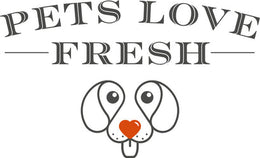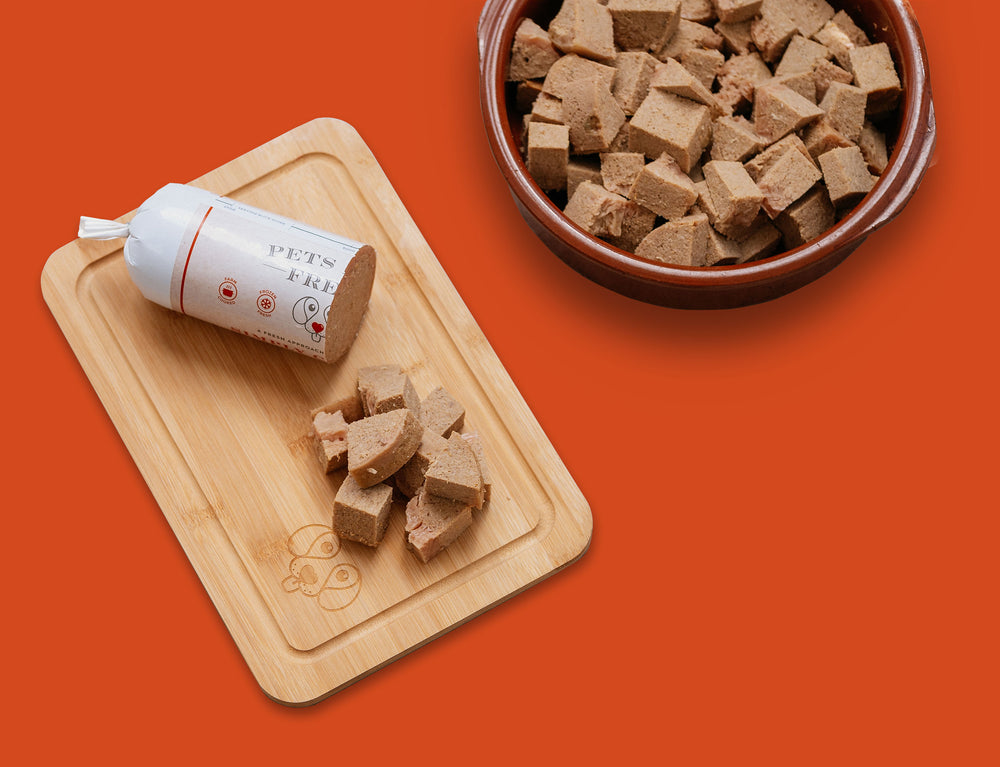What Is Fresh Dog Food?
When it comes to dog food - or human food - ‘fresh’ means food that has no preservatives, isn’t highly processed or dried out, and is still tasty and safe to eat. Fruit, vegetables and grains can remain ‘fresh’ for a relatively long time - depending on the type of product and how it is stored - while almost all poultry and meat spoils much faster without preservatives.
In a supermarket, most fresh food will be found in the produce, refrigerated and freezer sections, while the room-temperature aisles are mostly filled with non-fresh food that has been processed, dried and/or had preservatives added. These types of foods - crisps, candy bars and canned soup, for example - are completely fine to eat, but for optimum nutrition, they shouldn’t make up the majority of your diet.
Numerous studies have shown that you get the most nutrients from food that is fresh or freshly frozen - and it’s exactly the same for dog food.
So yes, fresh dog food is better - but only if it’s prepared properly to ensure it’s safe for your dog to eat, meets all of a dog’s complex nutritional needs and maintains high levels of vitamins, minerals and other nutrients.
At Pets Love Fresh, we use all-natural, fresh, human-grade ingredients, sourced directly from British farms.
Fresh Dog Food vs Raw Dog Food
While most store-bought dog foods can claim to have 'meat' with just 4% of the protein coming from actual meat, our fresh dog food contains between 62% and 70% British farmed chicken, pork or beef (meat that would normally be going to the UK supermarkets for human food). Dogs require high levels of protein in their diets, and shop-bought dog food falls far below optimum levels for this - and other nutrients.
Raw food and fresh food are not the same thing. Raw food is completely uncooked, and so even if it is fresh, it could have parasites or other bugs in it. Of course, it can also go off quickly and become spoiled or rotten - the opposite of fresh.
'Fresh' dog food is any dog food in an edible, palatable state with no preservatives added. It can be either raw or cooked.
In order to ensure it is safe for your dog to eat, it’s best if fresh food is cooked to eliminate harmful pathogens, such as salmonella and listeria monocytogens, which can cause illness and even death in your pets, and can also be transmitted to humans.
At Pets Love Fresh, we gently cook all of our fresh dog food to ensure bacteria and other pathogens are eliminated. By cooking at low temperatures for a longer time, we ensure the maximum natural nutrition remain in the food. What’s more, dogs, like humans, find gently cooked food easier to digest than raw food.
So Is Fresh Food Better For Dogs?
Without a doubt, fresh food is better for dogs - but only if it takes into account all of your pet’s nutritional needs. Feeding your dog exclusively fresh chicken breasts or even fancy cuts of steak will result in an animal who is malnourished, leading to serious illness. Those foods are wonderful as the occasional treat, but not as their entire diet.
A lot of people want to know how to make fresh dog food, but it’s not as easy as it sounds. To maintain optimum health, your dog needs to eat the right mix of protein, carbohydrates, fats, vitamins and minerals.
Long-life shop-bought dog foods usually have too much carbohydrate, preservatives and fillers, and not enough protein, vitamins and minerals. Conversely, when people try to feed their dogs with only home-cooked meals, they often end up giving them too much protein and not enough of the right carbs, fats, vitamins and minerals.

Is Fresh Food the Best Diet for your Dog?
When you think about how dogs that don’t live with humans survive - and thrive - you can start to understand how complex their ideal diet is.
Dogs that live in the wild hunt in packs, eating their prey fresh and whole, including organs. They will also scavenge the remains of kills from other animals. But crucially, they eat all of the animal, leaving no scraps, which means consuming the stomach contents of their prey - typically filled with grasses and plant matter. They also supplement their diet with vegetables and roughage to aid with digestion.
What dogs don’t eat in the wild are synthetic preservatives and foods that have been highly cooked and processed. Stray dogs in cities sometimes have no choice but to resort to this, but unfortunately, their life spans are also significantly shortened.
Stray dogs reliant on scraps of human food tend to live only one to three years, compared with 7-12 years for wild dogs and 15-17 years for dogs that live with people who look after them.
To provide your dog with a well-balanced diet that has the optimum nutrition, you need to plan meals carefully, under the supervision of a vet. Alternatively, you can feed your dog perfectly balanced, highly nutritious fresh dog food that’s vet approved and made with human-grade food, such as the fresh dog food we make at Pets Love Fresh, delivered freshly frozen straight to your door.

How To Feed Your Dog Fresh Dog Food
Feeding your dog fresh food is the best way to ensure they get the most nutrition from their food - but it’s crucial to ensure you’re feeding them the right fresh food.
Dogs have different nutritional needs than humans, which is why dogs can get very ill and even die if they eat grapes, coffee, chocolate, macadamia nuts and the sweetener xylitol - all of which can form part of a healthy human diet. Feeding your dog a home-cooked pork chop without the bone every now and then is fine, of course, but only as an occasional treat.
Our lightly cooked fresh dog food at Pets Love Fresh provides the perfect balance for your dog’s needs - and we also have packs especially made for puppies, who require higher fat content.
Pets Love Fresh dog food has been designed with vets and pet nutritionists to ensure it provides the optimum level of nutrition for your dog.
How Much Fresh Dog Food to Feed a Dog?
Determining the right amount of fresh dog food to feed depends on a few vectors, because as we know, every dog is different. This includes but is not limited to their size, age, activity level and specific dietary requirements. We recommend following the feeding guidelines on the packaging of our fresh dog food where our recipes range from chicken, beef and pork.
However, it’s important to consult a veterinarian to get expert advice for your dog's needs, especially, if they’re currently dealing with a medical issue. They will give your dog a routine check up and create a feeding chart and plan based on your dog's weight, condition and overall health.
Benefits of Fresh Dog Food
Healthy & Shiny Coat: This diet includes all the necessary nutrients for healthy skin and coat, addressing issues such as itchy skin, hair loss and rashes.
Improved Oral Health: The ingredients used in our fresh dog food, promotes cleaner teeth and reduces plaque build up.
Boost Energy & Recovery: Nutrient dense ingredients like chicken keep your dog feeling fuller and boost their recovery especially after a long day of walking!
Better Digestive Health: We use high fiber ingredients to reduce digestive discomfort, making your dogs poop easier whilst making it less smelly too!
Longer Life Span: Our fresh dog food recipes are filled with high protein and antioxidants that include important vitamins and minerals that guard against diseases, potentially adding years to your dogs life!
The Best Fresh Dog Food Delivery Service
If you want to feed your dog a well-balanced, highly nutritious diet, then try one of our Pets Love Fresh taster packs. Our fresh dog food is made with high levels of human-grade chicken, beef, pork and eggs, plus organic brown rice, seaweed and vitamins and minerals for digestion and nutrition.
Click to order your Pets Love Fresh adult dog or puppy taster pack.


